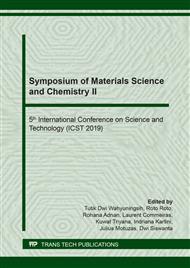[1]
F. J. O'Brien, Biomaterials and scaffolds for tissue engineering, Mater. Today 14 (2011) 88-95.
Google Scholar
[2]
Y. Tabata, Tissue Regeneration Based on Drug Delivery Technology, Topics in Tissue Engineering, (2003).
Google Scholar
[3]
W. Wattanutchariya, W. Changkowchai, Characterization of porous scaffold from chitosan-gelatin/hydroxyapatite for bone grafting, Proceedings of IMECS 2 (2014).
Google Scholar
[4]
K. A. Blackwood, N. Bock, T. R. Dargaville, M. A. Woodruff, Scaffolds for growth factor delivery as applied to bone tissue engineering, Int. J. Polym. Sci. 2012 (2012) 1-25.
DOI: 10.1155/2012/174942
Google Scholar
[5]
H. Tai, M.L. Mather, D. Howard, W. Wang, L.J. White, J.A. Crowe, S.P. Morgan, A. Chandra, D.J. Williams, S.M. Howdle, K.M. Shakesheff, Control of pore size and structure of tissue engineering scaffolds produced by supercritical fluid processing, Eur. Cell. Mater. 14 (2007) 64-77.
DOI: 10.22203/ecm.v014a07
Google Scholar
[6]
J.E. Davies, R. Matta, V.C. Mendes, P.S.P. de Carvalho, Development, characterization and clinical use of a biodegradable composite scaffold for bone engineering in oro-maxillo-facial surgery, Organogenesis 6 (2010) 161-166.
DOI: 10.4161/org.6.3.12392
Google Scholar
[7]
A. J. Salgado, O.P. Coutinho, R.L. Reis, Bone tissue engineering: state of the art and future trends, Macromol. Biosci. 4 (2004) 743-765.
DOI: 10.1002/mabi.200400026
Google Scholar
[8]
K.A. Al-Salihi, In vitro evaluation of Malaysian natural coral porites bone graft subtitutes (CORAGRAF) for bone tissue engineering: a preliminary study, Braz. J. Oral Sci. 8 (2009) 210-216.
Google Scholar
[9]
R. Hou, F. Chen, Y. Yang, X. Cheng, Z. Gao, H.O. Yang, W. Wu, T. Mao, Comparative study between coral-mesenchymal stem cells rhBMP-2 composite and auto-bone-graft in rabbit critical-sized cranial defect model, J. Biomed. Mater. Res. A 80A (2007) 85-93.
DOI: 10.1002/jbm.a.30840
Google Scholar
[10]
A.M. Parizi, A. Oryan, Z.S. Sarvestani, A.B. Sadegh, Effectiveness of synthetic hydroxyapatite versus parsian gulf coral in an animal model of long bone defect reconstruction, J. Orthop. Traumatol. 14 (2013) 259-268.
DOI: 10.1007/s10195-013-0261-z
Google Scholar
[11]
J. Ratanavaraporn, S. Damrongsakkul, N. Sanchavanakit, T. Banaprasert, S. Kanokpanont, Comparison of gelatin and collagen scaffold for fibroblast cell culture, Journal of Metals, Materials and Minerals 16 (2006) 31-36.
Google Scholar
[12]
S. Young, M. Wong, Y. Tabata, A.G. Mikos, Gelatin as a delivery vehicle for the controlled release bioactive molecule, J. Control Release 109 (2005) 256-274.
DOI: 10.1016/j.jconrel.2005.09.023
Google Scholar
[13]
A.A. Karem, R. Bhat, Fish gelatin: properties, challenges and prospects as an alternative to mammalian gelatins, Food Hydrocoll. 23 (2009) 563-576.
DOI: 10.1016/j.foodhyd.2008.07.002
Google Scholar
[14]
V. Patel, S.K. Dwivedi, A review: polarity of molecules, IJPRS 2 (2013) 549-561.
Google Scholar
[15]
K. Pal, A.K. Banthia, D.K. Majumdar, Polymeric hydrogels: characterization and biomedical applications, a mini review, Des. Monomers Polym. 12 (2009) 197-220.
DOI: 10.1163/156855509x436030
Google Scholar
[16]
E.S. Mahanani, I. Bachtiar, I.D. Ana, Human mesenchymal stem cells behavior on synthetic coral scaffold, Key Eng. Mater. 696 (2016) 205-211.
DOI: 10.4028/www.scientific.net/kem.696.205
Google Scholar
[17]
S.C. Leeuwenburgh, I.D. Ana, J.A. Jansen, Sodium citrate as an effective dispersant for synthesis of inorganic-organic composites with nanodispersed mineral phase, Acta Biomater. 6 (2010) 836-844.
DOI: 10.1016/j.actbio.2009.09.005
Google Scholar
[18]
A.B. Hassan, Human bone tissue engineering using coral and differentiated osteoblasts from derived-mesenchymal stem cells, thesis, Universiti Sains Malaysia, (2008).
Google Scholar
[19]
K.C.S. Figueiredo, T.L.M. Alves, C.P. Borges, Poly(vinyl alcohol) films crosslinked by glutaraldehyde under mild conditions, J. Appl. Polym Sci. 111 (2009) 3074-3080.
DOI: 10.1002/app.29263
Google Scholar
[20]
C.M. Murphy, M.G. Haugh, F.J. O'Brien, The effect of mean pore size on cell attachment, proliferation and migration in collagen-glycosaminoglycan scaffolds for tissue engineering, Biomaterials 31 (2010) 461-466.
DOI: 10.1016/j.biomaterials.2009.09.063
Google Scholar
[21]
V. Karageorgiou, D. Kaplan, Porosity of 3D biomaterial scaffolds and osteogenesis, Biomaterials 26 (2005) 5474-5491.
DOI: 10.1016/j.biomaterials.2005.02.002
Google Scholar
[22]
E.G. Khaled, M. Saleh, S. Hindocha, M. Griffin, W.S. Khan, Tissue engineering for bone production-stem cells, gene therapy and scaffolds, Open Orthop. J. 5 (2011) 289-295.
DOI: 10.2174/1874325001105010289
Google Scholar
[23]
H.G. Kang, S.Y. Kim, Y.M. Lee, Novel porous gelatin scaffolds by overrun/particle leaching process for tissue engineering applications, J. Biomed. Mater. Res. B Appl. Biomater. 79 (2006) 388-397.
DOI: 10.1002/jbm.b.30553
Google Scholar
[24]
C.E. Holy, M.S. Shoichet, J.E. Davies, Engineering three-dimensional bone tissue in vitro using biodegradable scaffolds: investigating initial cell-seeding density and culture period, J. Biomed. Mater. Res. 51 (2000) 376-382.
DOI: 10.1002/1097-4636(20000905)51:3<376::aid-jbm11>3.0.co;2-g
Google Scholar
[25]
L. Olah, L. Borbas, Properties of calcium carbonate-containing composite scaffolds, Acta Bioeng. Biomech. 10 (2008) 61-66.
Google Scholar
[26]
V.V. Gaikwad, A.B. Patil, M. V. Gaikwad, Scaffold for drug delivery in tissue engineering, International Journal of Pharmaceutical Sciences and Nanotechnology 1 (2008) 113-122.
DOI: 10.37285/ijpsn.2008.1.2.1
Google Scholar
[27]
T. Garg, O. Singh, S. Arora, R.S.R. Murthy, Scaffold: a novel carrier for cell and drug delivery, Crit. Rev. Ther. Drug. Carrier Syst. 29 (2012) 1-63.
DOI: 10.1615/critrevtherdrugcarriersyst.v29.i1.10
Google Scholar
[28]
H.H. Nitzsche, Development and characterization of nano-hydroxyapatite-collagen-chitosan scaffolds for bone regeneration, dissertation, Martin Luther Universität, (2010).
Google Scholar


